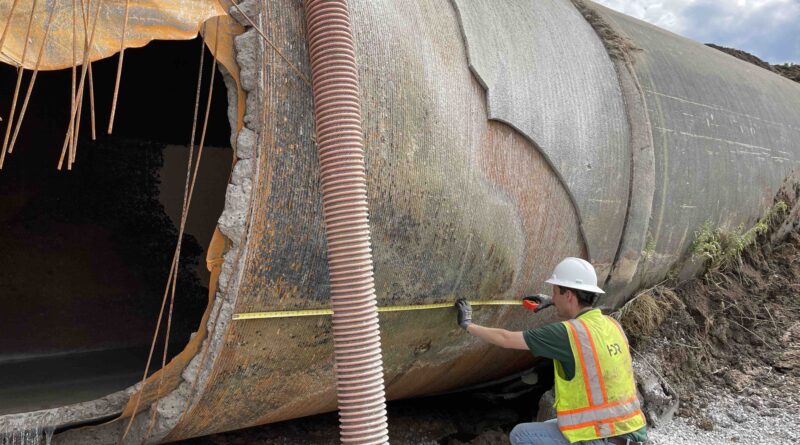From Breakage to Restoration
After a leak was detected on a 120-Inch water transmission main in Michigan, project crews quickly worked to restore its functionality
By Hanna Heiss
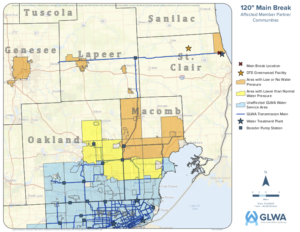
A leak was detected on a 120-inch water transmission main by the Great Lakes Water Authority (GLWA) in the early morning hours of Saturday, Aug. 13, 2022. The 120-inch transmission main, the largest in the regional water distribution system, delivers finished, potable drinking water from the Lake Huron Water Treatment facilities to communities located in the northern part of GLWA’s drinking water service area in southeast Michigan.
Providing drinking water services to nearly 40 percent, and efficient and effective wastewater services to nearly 30 percent of Michigan’s population, GLWA plays an important role in the region’s water services. GLWA is uniquely positioned, allowing for the Great Lakes to be its water source meaning for high water quality. Along with 88 member partner communities, GLWA also has the capacity to extend its services beyond those covered. In response to water affordability, GLWA offers a Water Residential Assistance Program. This allows low-income households within the 88 participating communities to receive a broad range of service assistance.
The water transmission main, the largest in diameter in the system in question, extends approximately 26 miles from the Lake Huron Water Treatment Plant (LHWTP) to the Imlay City Booster Pump Station (IMC). Installed in the early 1970s, the main has a normal operating pressure of up to 200 psi (pounds per square inch). LHWTP also has a flow rate of approximately 162 million gallons of water per day. Though experiencing failure in 1985, with little surviving information with respect to the cause, the main had no other issues prior to the 2022 summer breakage.
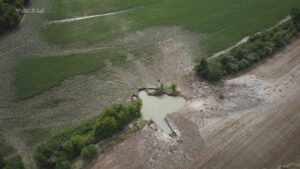
A precautionary Boil Water Advisory was issued due to changes in water pressure levels for the 23 initially impacted communities, amounting to a total of 935,000 affected persons. Such precautionary measures are taken when a water system’s pressure dips below 20 psi, as pressure loss can lead to water system bacterial contamination.
It was found that the water system had been operating under normal conditions prior to the break, and the determined cause was damage to the mortar casing covering the prestressed concrete pressure pipe (PCCP). The damage resulted in corrosion and hydrogen embrittlement of the pipe’s interior wires. The cause of the damage was deemed unknown.
The breakage also resulted in extensive temporary flooding to the area, though due to location, caused no damage to nearby residents.
The repair process was made up of three phases: water main inspection and repair; water main disinfection; and restoration of the water transmission main to normal operations.
Ric-Man Corporation and Lakeshore Global Corporation, GLWA’s emergency contractors immediately mobilized the site the night of the incident, securing the break area and began isolation and recovery procedures.
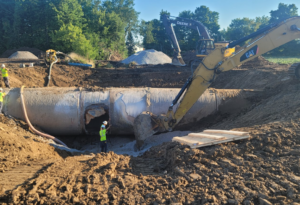
GLWA was able to restore pressures to near-normal levels by the evening of Sunday, Aug. 14, 2022 by reversing flow at the North Service Center Booster Pump Station (NSC). This allowed water to be pumped north through a 96-inch main to feed the Rochester Booster Pump Station, Romeo (Industrial Park), Bruce Township, Washington and Macomb Townships, and the Village of Almont.
Project crews worked to complete the placement of the new segments of the pipe at the site of the broken main, located just west of GLWA’s LHWTP. A concrete foundation was also poured underneath the new pipe segments, allowing for long-term stabilization. Following segment placement, LHWTP produced the 81 million gallons of water necessary to refill the 26 miles of the main.
In collaboration with the Michigan Department of Environment, Great Lakes and Energy (EGLE), GLWA implemented flushing and disinfection to the length of the pipe.
Though taking two weeks longer than projected, the emergency repair of the transmission main was completed and was returned to normal service as well as to normal regional operations on Oct. 3, 2022, just ahead of its projected timeline of Oct. 5, 2022, updated from Sept. 21, 2022. Upon restoration of operations, GLWA lifted the request that the affected communities limit outdoor water usage.
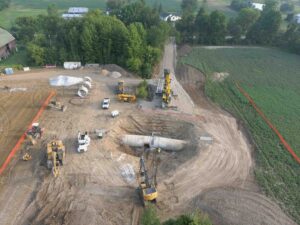
The emergency repair project was the 2023 APWA (American Public Works Association) Project of the Year in the Disaster or Emergency Construction/Repair category for projects amounting to $5 million or less in costs.
“On behalf of everyone at GLWA, I want to express my gratitude to our member partner communities and their residents for their collaboration and support as we worked through the complexities of the break on what is the largest pipe in our regional system,” said Suzanne R. Coffey, GLWA chief executive officer. “Although we encountered a number of obstacles along the way, I am so proud of how everyone involved dug in and used their knowledge, skills and ingenuity to ensure that we made the repair as quickly as possible and kept our focus on protecting public health.”
Hanna Heiss is a senior editor for American Infrastructure. She may be reached at hanna@builder.media.

